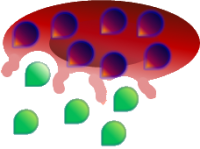Drug resistance is a problem. We can measure the devastation multi-drug resistance causes in financial figures and mortalities, and they all drive home the same point we focus on in our research day-to-day and which Andrew brings up in his class and TED talk: evolution is killing us. Antibiotics, antimalarials, cancer drugs, antiretrovirals, all have the same story. In malaria, it is a problem that has rapidly emerged after implementation of every drug we have ever brought to market. It seems like the explanation is simple: human intervention via drugs exerts selection pressure on bugs. The more drugs we use, the more pressure we are putting on bugs to evade them. But here is something I don’t understand: many, if not all, of these drugs were developed to mimic active ingredients in medicinal plants that we used centuries before the existence of big pharmaceutical companies. Why did resistance to the plants (and their active compounds) not develop over this time and interfere with their functionality before we brought them to market via big pharma?
Artemisinin has been in use for 2,000 years. We have found “prescriptions” for artemisinin in malaria cases from the notes of Chinese herbalist Li Shizhen — in 1596 he wrote that fevers should be treated as follows: “take a handful of sweet wormwood, soak it in a sheng of water, squeeze out the juice and drink it all,” (Meshnick 2002). Sweet wormwood, qinghao, is the same plant source we use in modern day artemisinin therapies: Artemisia annua. Evidence of artemisinin (ART) resistance and treatment failure is recent, with WHO issuing an official emergency response for containment of ART-resistance in 2013. Two thousand years of herbal use led to no problems, but less than 30 years of pharmaceutical production, and we have huge problems with resistance.
Artemisinin is not the only antimalarial that has this story. Quinine resistance also followed from the introduction of pharmaceutical production despite having long-term use as a traditional medicinal in its plant form. Why this trend?
I can come up with several possible explanations:
1. Maybe the concentration of active compound in plants is much lower than the concentration put in a pill that we can pop. That would translate to a lower selection pressure and a lower probability for resistance to emerge.
2. Maybe drug resistance did exist in populations chewing on cinchona bark (the source of quinine), etc., but without the abilities we have now to document treatment responses and genotype parasite profiles, we lack historical evidence for resistance to medicinal plants.
3. Maybe access to medicinal plants and the knowledge base of what plants to use was not widely spread, consequentially there wasn’t the same degree of pressure for parasites to evolve resistance as there is now. (This seems doubtful. If you have ever traveled to an area where traditional healers are more common than allopathy, the knowledge is as widespread as our use of chicken soup for a cold.)
4. Maybe plants and their synthetic or pharmaceutical derivatives from geographic regions more distant from a population are more effective than that population’s native plants and derivatives. For example, we could ask: have areas where the cinchona tree is native developed resistance to quinine more rapidly than areas where the plant is not native? If the answer is yes, than resistance to quinine may have already been developing under use of the plant, and thus emerged quicker where the trait was already present in the parasite population at the time of quinine introduction.
5. Maybe there are other compounds in medicinal plants besides the one active ingredient we tend to isolate that make plants “evolution proof.” Could medicinal plants be similar to combination therapies and we are not considering all possible components plants contain in terms of their antiparasitic abilities? Are we missing something when we isolate an active component?
6. Maybe synthetic versions are less potent than the natural plant because of differences in d vs. l enantiomer concentration. In vitamin E we know that the vitamin extracted from the plant is much more potent than the synthetic version because of differences in stereochemistry. It has so far been impossible to make a synthetic version that is not a racemic mixture. If the body recognizes synthetics vs. natural forms of the same compound differently, maybe synthetic antimalarial compounds could also be exerting a different selection pressure on parasites, leading to drug resistance?
A recent article in PLOS ONE may convince you that hypothesis #5 has some validity for explaining why artemisinin resistance appears to be a recent development despite long-term use of the natural plant. The study by Elfawal et al compared treatment responses between whole plant powdered leaves of A. annua (14.8 mg artemisinin per gram of dried leaf) and a comparable dose from pure drug. The results showed an obvious discrepancy in effectiveness, with whole plant treated mice having lower parasitemia and faster parasite clearance. Only when the dose of pure drug was at a dose five times higher than the dose of whole plant was the outcome of treatment comparable (24mg/kg artemisinin in whole plant treatment had the same outcome as 120 mg/kg of artemisinin pure drug).
This result suggests that either artemisinin in whole plant form is more potent or there are other compounds in A. annua that act synergistically in treatment accounting for the reduction in efficacy of the artemisinin pure drug. The authors provide evidence that either possibility could be occurring, citing work that has shown that artemisinin in plant form is more bioavailable and that there are also particular flavonoids in the whole plant that could contribute to synergism. If flavonoids or other molecules in the whole plant are contributing to the enhanced potency, the authors suggest that whole plant therapy may be more similar to combination therapies currently in use rather than monotherapy with artemisinin.
Our current understanding of resistance suggests that resistance is less likely to emerge to a particular drug when used in combination with other drugs as the likelihood that resistance to multiple selection pressures occurs at once is less than the likelihood of resistance emerging to just one selection pressure, particularly if there is a fitness cost to resistance mutations. This has led to current implementations of combination therapy in treatment for HIV/AIDS and malaria. It looks like nature may have come up with this idea well before our antimalarial combo drugs. Is A. annua the original combination therapy? And is that what delayed resistance to artemisinin compounds for 2,000 years?
Seems to me like plants may be smarter than we think.
Source: Meshnick, S. R. Artemisinin: Mechanisms of action, resistance and toxicity. International Journal for Parasitology 32 (2002): 1655-1660.




